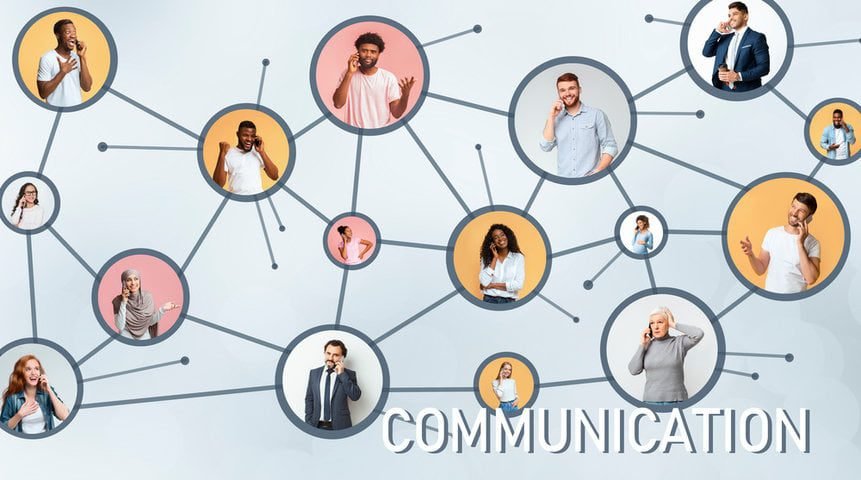PRINCIPLE OF COMMUNICATION
Communication is drawn from the Latin word ‘communis,’ which means common. Communication is a dynamic process of action and interaction through sharing or exchanging ideas, information, knowledge, attitudes, or feelings among two or more persons through certain signs and symbols toward a desired goal to achieve commonality.
In This Article
Communication is a basic human need, like food, clothing, or shelter.
Through communication, every living being attains some commonality or understanding, which is essential to function as a living being.
Communication is also an integral part of one’s life as a social process. Communication tends to satisfy our physical, emotional, or other needs to get work done, so it can be said that society cannot survive in the absence of communication.
In this entire process, there are some obvious questions like:
Who is involved? – A Sender and a Receiver
What is being communicated? – A message.
Through what means? – A channel
Therefore, the simplest form of communication requires:

NATURE OF COMMUNICATION
Communication is a dynamic process. That means the process has no beginning, end, or fixed sequence of events. Also, one can’t freeze communication at any point. A message from one individual creates a response message continuously. In this context, communication is also said to be an ongoing, ever-changing, and continuous act.
LEVELS OF COMMUNICATION
Depending on the number and nature of persons involved, communication attains different levels and, in some cases, requires various technologies. The levels of communication are:
- Intrapersonal communication
- Interpersonal communication
- Group communication
- Public communication
- Mass communication
Intrapersonal Communication

Communication within the self is called intrapersonal communication—the individual functions here as both source and receiver.
Self-awareness is the basis for intrapersonal communication, defining how one sees oneself and others.
Interpersonal Communication

Interpersonal communication is the interaction between people to exchange ideas, feelings, and thoughts through verbal and nonverbal messages.
It is a personal, two-way communication, hence the most effective one.
It is face-to-face or through mediated technology like phone, online chat, video calling, etc.
Interpersonal communication between two individuals is also called Dyadic communication.
Group Communication

What is a group?
A group is a collection of individuals, though not in large numbers, with a common goal of coming together. Usually, the group size is such that they can communicate relatively easily with a common purpose and some degree of structure.
In a group, communication may take place at any level:
- One person communicates with many persons,
- Many persons communicate with one person
- Many persons communicate with all or many in the group
Group communication is effective when organized with a specific agenda and enough homework. It is relatively direct, intimate, effective, and has room for adequate feedback.
Public Communication

In public communication, one or more speaker addresses a comparatively large audience in a face-to-face or mediated situation. Public gatherings organized by political parties are examples of face-to-face public communication. Video conferencing is an example of mediated public communication.
What makes public communication effective?
- Speaker’s social position, knowledge of the subject, and the audience.
- Feedback is very minimal in public communication.
Mass Communication

What is Mass?
Mass in the context of mass communication means a collection of significant, heterogeneous, widely dispersed, and unknown individuals.
The mass may be constituted by different unorganized societies based on language, culture, ethnicity, profession, religion, etc.
Mass media refers to communication channels such as newspapers, magazines, television, radio, film, and multimedia websites.
What is Mass Communication?
Mass communication is a message from a source delivered simultaneously to a larger audience in real time.
FUNCTIONS OF COMMUNICATION
In a social context, understanding the function of communication is vital for human existence and the progress of humanity. No person, group, or society can exist without interaction with others.
Nowadays, as society becomes more complex, the mass media primarily take over social action and interaction, and mass communication functions as a related tool that creates understanding facilitates work, and strengthens collective living among people.
| FUNCTIONS OF COMMUNICATION | |
| PRIMARY FUNCTION (inform, instruct/educate, entertain, influence/persuade). | SECONDARY FUNCTION (debates & discussions, cultural promotion, integration, etc). |
Information
Information is now regarded as power. The more informed you are, the more powerful you become. Communication provides us with enormous information about the environment in which we live. Information such as news of war, danger, crises, famine, etc, helps us in taking appropriate steps to safeguard our interests. In this way, information facilitates innovation, adaptation, and progress.
Instruction
Instruction is one of the significant functions of communication. One of its essential characteristics is to educate. It starts in the early stage of life, continues till the end, and varies according to situation. Communication provides a fund of knowledge, expertise, and skills that enable people to operate as influential members of society. It also creates awareness and gives direction and opportunity to people so that they actively participate in public life.
Entertainment
Communication provides entertainment to break the monotony of routine life. It diverts attention from the troubles and tensions to recharge and even educate us. Some means of entertainment, like movies, music, stage drama, art, literature, sports, etc., entertain and simultaneously make a statement on life.
Persuasion
Persuasion helps reach a decision or consensus on public policy, which allows authority or concerned person to control and govern.
Debate and Discussion
It helps to bring out different viewpoints on issues of public interest and arrive at general agreement on matters that concern all.
Cultural Promotion
Communication Provides an opportunity for an individual to preserve and promote their culture. It could be at any level, either personal or organizational.
Integration
Communication is an excellent integrating tool. Individuals and groups based on information or cultures, individuals and groups come to know one another, understand and appreciate other viewpoints, and develop commonness towards one another.
7 C’S OF COMMUNICATION
Credibility
Communication starts with mutual belief between the communicator and receiver. However, the responsibility of belief building is on the part of the communicator; he built a climate of trust through his performance. The performance reflects an earnest desire to serve the receiver. The receiver must have confidence in the sender regarding his competence.
Context
The context of the message is so designed that it confirms and does not contradict the beliefs. It must have an essence to encourage participation and generate responses accordingly.
Content
The content determines the audience. Hence, the message must have meaning for the receiver and be relevant and compatible with their value system.
Clarity
The message should be put in simple terms to convey the meaning. In particular, complex issues must be designed with simplicity and clarity. Words must mean the same thing to the receiver as to the sender.
Continuity & Consistency
The message needs to be continuous so that the communication process is consistent. Sometimes, it also requires repletion to achieve penetration. The effectiveness of communication depends largely on this fact.
Channels
The channels are the physical means through which the signals of a message are transmitted from the transmitter to the receiver.
Only established communication channels must be used to contain the message. The selected channel must be audience/viewers/listeners oriented according to the target group. However, different media have different effects and serve effectively in various stages.
Capability of Audience
Communication must take into account the capability of the audience. It is most effective when it requires the least effort from the recipient. This includes message availability, perception-interpretation-retention habit, knowledge, socio-economic-cultural background, etc.





